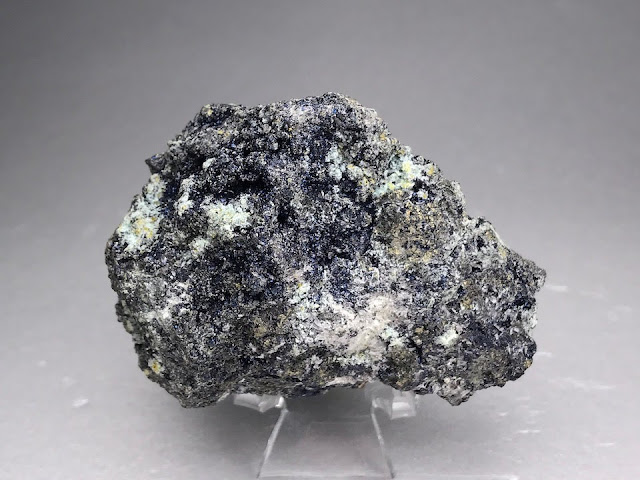花岡の銅藍 Covellite from Hanaoka
標本幅 width 60 mm / 重さ weight 126 g
黒鉱鉱床の酸化帯に径 0.3 mm くらいの鱗片状の青黒い銅藍(コベリン)が多数結晶した。黄銅鉱の残りカスもみられる。大きさの割に重いので、おそらく中まで銅成分が充満しているのだろう。結晶は微細だが、この鉱物に独特のメタリック・ブルーの輝きはじゅうぶん堪能できる。なおおなじ秋田県の黒鉱鉱山である小坂鉱山からは直径 15 mm、厚さ 1.5 mm のりっぱな六角板状結晶が出たという(和田維四郎、日本鉱物誌・改訂版、1916)。
文献(科野房三、秋田県花岡鉱山調査報告、地質調査所報告 128 号、1948)によると、当時、堤沢鉱床ではおもに硫化鉄(硫黄の原料)が坑道掘りされていた。地表から 25 m は火山岩・凝灰岩で、その下に東西 80 m、南北 170 m、深さ 45 m の塊状の黄鉱・石膏鉱床があった。鉱床南部に、銅の二次鉱物に富む部分があったとあるので、おそらくそのあたりで採取された標本だろう。この文献が書かれたあと、堤沢の採掘は露天掘りに切り替えられ、いまは水をたたえた池になっている。
Many blue covellite flakes of 0.3 mm in size crystallized in an oxidized kuroko deposit. Chalcopyrite also remains. This specimen significantly contains copper because it weighs more than it looks. The metallic blue is enough to enjoy though the crystal size is very small. Large hexagonal platy covellite of diameter 15 mm and of thickness 1.5 mm was found from Kosaka Mine, which is a similar kuroko mine in Akita.
In 1940s, pyrite was mined in Tsutsumizawa to produce sulfur (F. Shinano, The geology and ore deposits of the Hanaoka mine, Report of Geological Survey Japan, No. 128, 1948). The yellow-ore and gypsum deposits were located below the depth of 25 m from the surface and the size was 80 m from east to west, 170 m from north to south, and 45 m from top to bottom. Secondary copper minerals were found in the southern part of the ore body. Tsutsumizawa was developed by means of open-pit mining and it became a pond after mining.
参考
秋田大学鉱業博物館所蔵の銅藍標本(秋田県鹿角郡小坂町小坂鉱山産、標本番号 00262)。標本幅は 8 cm くらい。



